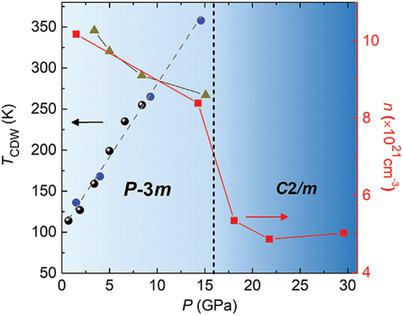当前位置:
X-MOL 学术
›
Adv. Electron. Mater.
›
论文详情
Our official English website, www.x-mol.net, welcomes your
feedback! (Note: you will need to create a separate account there.)
Achieving Room‐Temperature Charge Density Wave in Transition Metal Dichalcogenide 1T‐VSe2
Advanced Electronic Materials ( IF 5.3 ) Pub Date : 2020-03-13 , DOI: 10.1002/aelm.201901427 Jiajia Feng 1, 2 , Resta A. Susilo 2 , Bencheng Lin 1 , Wen Deng 2 , Yanju Wang 2 , Bin Li 3 , Kai Jiang 4 , Zhiqiang Chen 2 , Xiangzhuo Xing 1 , Zhixiang Shi 1 , Chunlei Wang 5 , Bin Chen 2
Advanced Electronic Materials ( IF 5.3 ) Pub Date : 2020-03-13 , DOI: 10.1002/aelm.201901427 Jiajia Feng 1, 2 , Resta A. Susilo 2 , Bencheng Lin 1 , Wen Deng 2 , Yanju Wang 2 , Bin Li 3 , Kai Jiang 4 , Zhiqiang Chen 2 , Xiangzhuo Xing 1 , Zhixiang Shi 1 , Chunlei Wang 5 , Bin Chen 2
Affiliation

|
Charge density wave (CDW) systems have been widely studied and proposed to be potential candidates for next‐generation electronic devices. However, the lack of room‐temperature CDW materials has limited the development of CDW‐based electronic devices, and thus finding a way to manipulate the CDW transitions and orders toward room temperature will be of importance. Room‐temperature and above CDW transition in 1T‐VSe2 is reported. The CDW transition is found to shift to ≈114 K at 0.7 GPa, and further compression enhances the transition temperature dramatically, reaching ≈358 K at 14.6 GPa. High‐pressure Raman spectroscopy measurement confirms that room‐temperature CDW order is achieved and persists up to 15 GPa. Such significant enhancement in CDW can be attributed to the pressure enhanced out‐of‐plane Fermi surface nesting and CDW gap in 1T‐VSe2. The observation of room‐ and high‐temperature CDW transition in 1T‐VSe2 under pressure provides an engineering approach to optimizing the CDW as needed in applications, which does not only open up a new platform for searching and controlling novel states of two‐dimensional materials, but also promotes a practical development of CDW‐related technology and devices.
中文翻译:

在过渡金属硫族化物1T-VSe2中获得室温电荷密度波
电荷密度波(CDW)系统已被广泛研究,并被建议作为下一代电子设备的潜在候选者。但是,缺乏室温CDW材料限制了基于CDW的电子设备的发展,因此找到一种方法来操纵CDW过渡和向室温的顺序将很重要。1 T ‐VSe 2中室温和高于CDW的转变被报道。发现CDW跃迁在0.7 GPa时转变为≈114K,进一步压缩会大大提高转变温度,在14.6 GPa时达到≈358K。高压拉曼光谱测量证实了室温下CDW的定序,并保持高达15 GPa。CDW的显着增强可归因于压力增强的平面外费米表面嵌套和1 T- VSe 2中的CDW间隙。1 T ‐VSe 2中室温和高温CDW转变的观察 压力之下提供了一种工程学方法,可以根据应用程序的需要优化CDW,这不仅为搜索和控制二维材料的新状态开辟了一个新平台,而且还促进了CDW相关技术和设备的实用开发。
更新日期:2020-03-13
中文翻译:

在过渡金属硫族化物1T-VSe2中获得室温电荷密度波
电荷密度波(CDW)系统已被广泛研究,并被建议作为下一代电子设备的潜在候选者。但是,缺乏室温CDW材料限制了基于CDW的电子设备的发展,因此找到一种方法来操纵CDW过渡和向室温的顺序将很重要。1 T ‐VSe 2中室温和高于CDW的转变被报道。发现CDW跃迁在0.7 GPa时转变为≈114K,进一步压缩会大大提高转变温度,在14.6 GPa时达到≈358K。高压拉曼光谱测量证实了室温下CDW的定序,并保持高达15 GPa。CDW的显着增强可归因于压力增强的平面外费米表面嵌套和1 T- VSe 2中的CDW间隙。1 T ‐VSe 2中室温和高温CDW转变的观察 压力之下提供了一种工程学方法,可以根据应用程序的需要优化CDW,这不仅为搜索和控制二维材料的新状态开辟了一个新平台,而且还促进了CDW相关技术和设备的实用开发。











































 京公网安备 11010802027423号
京公网安备 11010802027423号